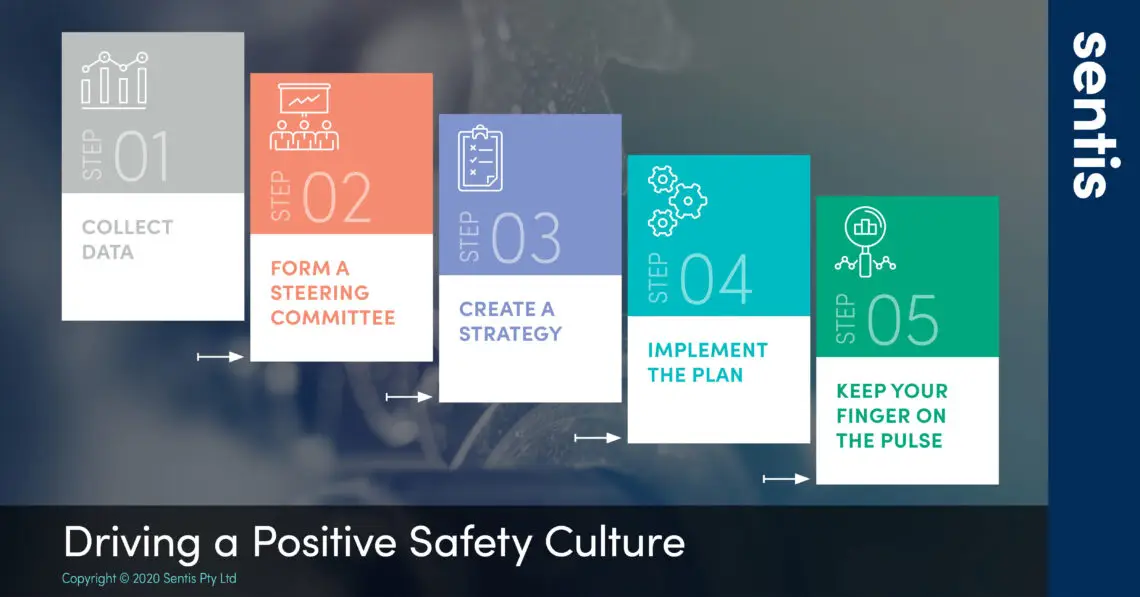When it comes to improving an organisation’s safety culture, we often focus our attention and planning processes around the specific activities that need to be implemented. From running safety training programs to revising our operating procedures and workplace protocols, most of our energy tends to be focused on what needs to be done to drive the results that we’re after. But while that might seem like the most effective approach to take, the reality is that the activities involved are only one part of the equation. The other crucial element for a successful safety culture development program is how effectively you introduce and embed those changes with your people.
You see, our brain has a natural tendency to create and sustain habits. While this helps us conserve energy by making us more likely to repeat similar patterns and behaviours, it also leads to us having a natural resistance to change. So, in order for cultural change to be successful, you need to keep this notion in mind by ensuring that you’ve got a strategic plan in place to not only execute on your new safety initiatives, but to also effectively manage the resistance to change that’ll inevitably arise. Otherwise, you might find yourself stuck with a plan that was perfect on paper but inefficient in practice as you face pushback and resistance from your workers at every turn.
Change isn’t always welcomed
As a leader, your perception of what defines a disruptive level of change may be substantially different from that of your workers. While you may consider a restructure, a merger or the closure of a site as being a major organisational change, your workers might experience that same level of disruption from much smaller changes to their daily routines, rosters or in the way that they do their jobs. This discrepancy gets amplified drastically when you’re implementing a culture development program as it may require multiple changes to be implemented simultaneously, leading to even more disruption and pushback from your workers.
Without an effective change management strategy in place, it can lead to your workers becoming anxious, withdrawn, hostile, disengaged with safety processes or even displaying an increased number of unhelpful safety behaviours—the opposite of what you were aiming for when you decided to invest in safety. With that in mind, when you’re looking to improve your organisation’s safety culture, where do you even begin?
Well, it starts with your perspective around safety culture development.
It all starts with your view on safety
Unlike other aspects of organisational change that could be addressed by simply hiring an external consultancy to come in and provide a quick-fix solution, safety culture development is substantially more complex. That’s because your culture is a fluid element of your organisation that’s constantly being moulded and influenced by the attitudes, behaviours and shared beliefs of everyone there. That means that without consistent nurturing and conscious direction, any short-term efforts to improve your culture will eventually be undone as the deep-rooted beliefs and safety habits that permeate your organisation continue to influence your culture and revert it back to where you started.
On the other hand, when you take a long-term view for safety culture by accepting that there’s no magic silver bullet that’ll fix it, and you invest the time and resources required to effectively introduce and sustain the changes you’re implementing, you give yourself the opportunity to drive safety results that will stand the test of time. Instead of being “done-for-you”, think of investing in your safety by engaging external safety culture experts as an activity that’s “done-with-you”.
While it might seem like a major endeavour, the reality is that your safety improvement efforts can be quite straight forward. All you need is a strategic plan in place to help you effectively execute on them. That’s why we’ve developed our 5-Step Roadmap For Change to help you get started on your journey towards a safer workplace.
5-Step Roadmap For Change
The plan for your plan

The process of effectively implementing a safety improvement program can be broken down into five key steps:
Step #1 – Start by collecting data
The first step in the process is to start by creating a clear, data-driven picture of the current state of your workplace safety. Through the use of focus groups, interviews, a safety climate survey or by engaging third-party safety experts to run safety culture diagnostics, the goal here is to help you benchmark exactly where your current safety performance lies. Not only will this give you a starting point to measure future successes against, but it’ll also make it crystal clear to your people that there is an immediate need for change when it comes to your safety performance.
Step #2 – Form a steering committee
Next, form a steering committee of key stakeholders to guide your safety improvement efforts with personal KPIs and accountabilities to keep your campaign moving forward. Not only will this help align your senior leaders towards the same common goal, but it also reinforces the fact your organisation’s safety efforts shouldn’t just be left to the safety manager or safety department alone.
Step #3 – Create a tailored strategy
With your committee in place, it’s now time to align your leaders on a shared safety vision and develop a strategic plan to execute on it. During this stage of the process, you’ll be building a simple document that captures the overarching safety goals and the key actions required to achieve progress towards your safety vision. This includes the breakdown of your goals into long-term (3-5 year), medium-term (1-year) and short-term (quarterly) goals to give you a step-by-step playbook to follow to drive your safety performance forward.
Step #4 – Implement your plan
It’s now time for execution. As you progress with your safety campaign, ensure that your strategy remains front-and-centre by discussing and referencing it regularly. By setting regular meetings with steering committee members to check in on their strategic actions, and by running quarterly reviews and analysis of your overall strategy, you can ensure that you’re moving in the right direction while concurrently reinforcing that safety is genuinely a priority within your business.
Step #5 – Keep your finger on the pulse
Finally, it’s time to analyse the data and revise your initiatives accordingly to ensure that they are driving your safety culture in the right direction. By regularly gathering data from your workers, and by comparing new data with previous benchmarks to identify areas of change, you can determine where your safety improvement efforts have been the most successful and identify any ongoing areas of opportunity or concern. In doing so, you can rest assured that your strategy is still valid and driving you forward towards your safety goals or pivot as required.
Failing To Plan Is Planning To Fail
As you can see, when it comes to improving your safety culture, the activities and initiatives involved with a safety improvement program are only one part of the equation. The other critical element for success comes down to the effectiveness of the strategy you have in place to introduce and implement these changes. Even with a clear safety vision in place, you still need to invest adequate time and resources to regularly analyse your progress and revise your campaign to ensure that it consistently drives you forward towards your safety goals. Otherwise, you may be stuck in a cycle of short-term results that are also short-lived as your safety culture continuously reverts back to where you began.
That’s why at Sentis, we pride ourselves on being safety culture experts who are here to guide you along every step of the safety improvement journey from initial safety assessments through to on-going analysis and optimisation. To help you get started on your own path towards safety excellence, we’ve broken down the journey of safety culture improvement in more detail in our latest ebook on driving a positive culture.
Download a copy for yourself today and gain a step-by-step insight into exactly what it takes to accelerate your safety performance at each stage of the journey.
As you continue to invest in your safety, keep in mind that as much as it’s your workers’ responsibility to adhere to any changes that you introduce, it’s also your responsibility to introduce those changes in a manner that serves them best.
In doing so, you can start to shift your perception of your people from being safety liabilities to viewing them as your greatest safety assets.




